
Table of Contents
SOIL MECHANICS – ONLINE GATE STUDY MATERIAL
VALUE IN GATE – 15 MARKS
PLEASE READ : THIS PAGE CONSISTS OF SOIL MECHANICS GATE SYLLABUS (ALMOST ALL THE REQUIRED TOPICS) STUDY MATERIAL COLLECTED FROM DIFFERENT SOURCES (TEXT BOOKS AND MATERIALS OF SEVERAL INDIAN AUTHORS). WE TRIED OUR LEVEL BEST TO BE MAKE THIS MATERIAL CLEAR AND UNDERSTANDABLE TO ANY KIND OF STUDENT. IN CASE YOU FIND ANY MISTAKE IN THIS ONLINE MATERIAL, KINDLY DROP US A NOTE TO OUR EMAIL (civilenggforall@gmail.com) WE WILL BE POSTING THE MATERIALS SIMILARLY TO OTHER SUBJECTS VERY SOON FOR THE BENEFIT OF STUDENTS PREPARING FOR GATE. THIS MATERIAL CONSISTS OF THEORY, SO KINDLY SOLVE THE PROBLEMS AS MANY AS POSSIBLE WITH THE HELP OF THE INFORMATION PROVIDED BELOW.
DOWNLOAD LINK OF THIS MATERIAL (PDF FORMAT) HAS BEEN PROVIDED AT THE END OF THIS POST

Soil Mechanics Free Online CivilEnggForAll GATE Study Material
CONTENTS
Origin Of Soils
Soil Classification
Three Phase Diagram
Index Properties Of Soil
- Relative Density
- Particle Size Distribution
- Consistency
- Atterberg’s Limits
Engineering Properties Of Soil
- Permeability
- Seepage
- Quick Sand And Piping
- Effective Stress
- Stress Distribution
- Consolidation
- Compaction
- Shear Strength
ORIGIN OF SOILS (0 Questions asked from last 6 years of GATE)
- Soils are formed from weathering of rocks and decomposition of organic matter.
- Types of weathering – Physical weathering: by temperature, frost action, abrasion etc. – Chemical weathering: oxidation, carbonation, hydrolysis etc.
- Different types of soils – Alluvial soil, Black soil (Cotton soil), Laterite soil, Sandy Soil etc.
- Alluvial soil is formed by river transportation, Black soil by chemical weathering and laterite soil by leaching.
SOIL CLASSIFICATION (0 Questions asked from last 6 years of GATE)
How can be soil classified?
- Classification based on origin and type of soil
- Residual soil: Soil formed by weathering and is deposited there itself.
- Transported soil: Soil transported by agents like water, wind, ice, glaciers etc.
Have a look at below types of transported soil and their respective agents.
| Types of Soil | Agents of Transportation |
| Alluvial | Rivers |
| Lacustrine | Lake |
| Marine | Ocean |
| Aeolian (Sane dunes, Loess) | Wind |
| Drift | Glacier |
| Till | Melting of glacier |
| Colluvial (Talus) | Gravitation |
THREE PHASE DIAGRAM (BLOCK DIAGRAM) (Minimum 1 Question from this topic in every year GATE Exam)
What are the contents of three phase diagram of soil?
- Unsaturated soil consists of solids, water and air which forms the three phase diagram
- Basic abbreviations used: Vs, Vw, Va represents volume of solids, water and air respectively V represents total volume.
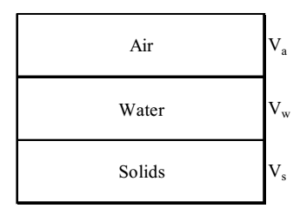
Vs , Vw , Va represents volume of solids, water and air respectively V represents total volume.
Vv = Va + Vw
V=Va + Vw + Vs = Vv + Vs
PROPERTIES
What are the volume relations of soil?
1. Void ratio e = Vv/Vs
Remember volume = weight/density (It can be used to solve some problems)
- Value of ‘e’ always greater than zero.
- e coarse grained < e fine grained
2. Porosity (η) or percentage voids
η = Vv/V
0 < η < 100%
Relationship between Void Ratio and Porosity
e = η/(1- η)
η = e/(1+e)
3. Degree of Saturation (Sr)
Sr = Vw x 100 / Vv
0 ≤ Sr ≤ 100%
Sr = 0 for dry soil and Sr = 1 for fully saturated soil.
4. Air content (ac)
ac = Va/Vv
ac = 0 for fully saturated soil and ac = 1 for dry soil.
Relationship between ac and Sr is
ac = 1-Sr or ac+Sr = 1
5. Percentage air voids (ηa)
ηa = Va x 100/V
0 ≤ ηa ≤ η
ηa for fully saturated soil and ηa= η for dry soil.
For dry soil, Vw=0 , therefore Vv = Va
Relationship between ηa, η and ac is ηa = η x ac
DENSITY OF SOLID MASS
1. Bulk Density
γb= W/V = (WW+WS)/V
2. Dry Density
γd = WS/V
3. Density of Solids
γS = WS/VS
(Unit wt. of solids) γs is constant for given soil, but γd is not.
4. Saturated density
γsat = Wsat/V
5. Submerged density (γsub or γ’) = Wsub/V
Wsub is Submerged Weight of Soil
Relationship between γsub and γsat is γsub = γsat – γw where γw is density of water
Water Content or Moisture Content WC = WW x 100/WS
WC > 0
WW, WS, W represents weight of water, solids and total weight
SPECIFIC GRAVITY OF SOLIDS
Specific Gravity (G) = γS/γw
G is measured at 270 C
G is usually taken as 2.65
γS is density of soil solids
γw is density of water
Apparent/Bulk/Mass Specific Gravity (Gm) = γb/γw
γb is bulk unit weight
Gm < G
For a given soil, G is constant but Gm is not.
Relationship between volume of soil, void ratio and dry density.
V1/V2 = (1+e1)/(1+e2) = γd2/γd1
SHORT-CUT TO STUDY THE PROPERTIES
This is a shortcut method to remember the properties of soil discussed above. Instead of studying the five properties we can just study the diagram given below. The arrow mark means ‘divided by’
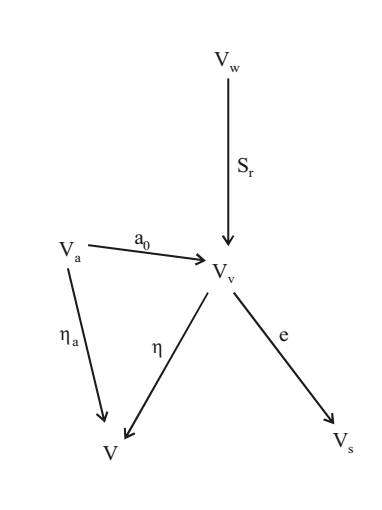
Example, Vw → Vv means Vw/Vv
The properties are shown nearby the arrows.
Example, Sr = Vw/Vv
FEW MORE FUNCTIONAL RELATIONSHIPS
Questions are frequently asked in GATE exam from this part. It is better to know all these equations. Also, workout some problems using these equations.
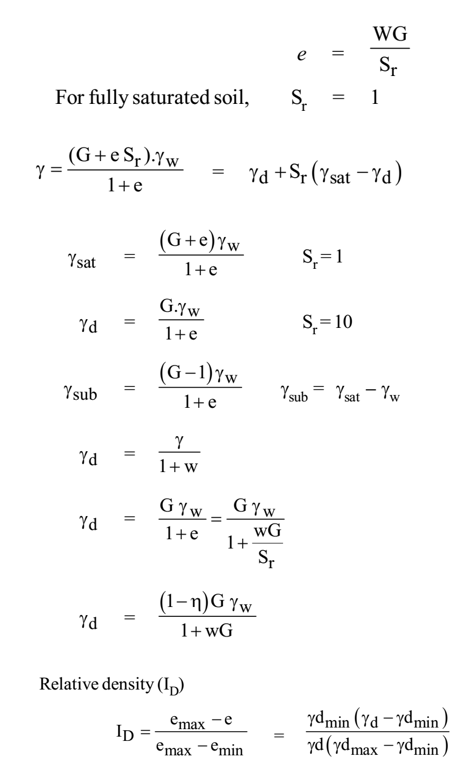
INDEX PROPERTIES OF SOIL
Main index properties of different types of soil are
Coarse grained soil – Relative density, particle size distribution
Fine grained soil – Atter berg’s limits, consistency of soil.
Relative density (ID) = x 100
emax is void ratio in its loosest state. (In loosest state, the volume of voids is maximum for unit volume of solids, so void ratio is maximum)
emin is void ratio in its densest state.
e is void ratio in natural state.
ID is expressed in percentage. So its value varies from zero to 100.
If ID is less than 35%, soil is said to be in loose dense state and if ID is above 85% soil is said to be very dense state.
Another equation of ID is ID = γdmax(γd – γdmin)/ γd(γdmax– γdmin)
PARTICLE SIZE DISTRIBUTION
Based on the soil particle/grain size soil can be classified as
| GRAIN SIZE (mm) | TYPE |
| Less than 0.002 mm | CLAY |
| 0.002 – 0.075 mm | SILT |
| 0.075 – 4.75 mm | SAND |
| 4.75 – 80 mm | GRAVEL |
POINTS TO REMEMBER
- Usually, clay and silt (size < 0.75 mm) is referred as fine grained soil and sand gravel (size > 0.75 mm) is referred as coarse grained soil.
- 1 mm = 1000 microns (1000 P) Example 0.075 mm = 75 P
- For particle size distribution, we use sieve analysis for coarse grained soil (< 75 P) and sedimentation analysis/ wet analysis for fine grained soil (< 75 P).
- Sedimentation analysis is based on Stoke’s Law in which the terminal velocity of the particle is found out.
Terminal Velocity, V = d2(γs-γw)/18µ= 9(S-1)d2/18ν ≈ 902 d2
µ and ν – dynamic and kinematic viscosity of water respectively.
Where, d – diameter of particle and γs – unit wt. of particle
- Sedimentation analysis can be done either by pipette method or hydrometer method.
- In these method, dispersion solution is prepared by adding 33 grams of sodium hexametaphosphate and 7g of sodium carbonate in distilled water.
PARTICLE SIZE DISTRIBUTION CURVE
It is a curve plotted on a semi-log graph which shows the gradation and type of soil. The log of diameter of particle is in the x-axis and the percentage finer is in the y-axis.

- Fine grained – most of the particles are of smaller size
- Coarse grained – most of the particles are of gravel size
- Uniformly grained – most of the particles are of same size
- Well grained – particles of all sizes are present in similar ratio
- Gap grained – particles of some sizes are found in even.
IMPORTANT TERMS IN PARTICLE SIZE DISTRIBUTION
Effective size (D10): The size of particle such that only 10% of the particle are less than this size. It is also called effective diameter and is usually represented in mm.
Uniformity coefficient (Cu)
Cu = D60/D10
where D60 means 60% of particles are finer than this size
Coefficient of curvature Cc = D302/(D60 x D10)
D30 means 30% of particles are less than this size.
Points to be noted
- Cu will be always greater than or equal to 1
- Uniformly graded soils will have Cu & Cc approximately equal to 1.
- Well graded soils will have Cc between 1 and 3
- Well graded gravel will have Cu ≥ 4 and well graded sand will have Cu ≥ 6
- Angularity of a particle = (Average radius of corners and edges)/(Radius of maximum inscribed circle)
- Based on angularity, particles can be classified as angular, sub angular, sub rounded, rounded, well rounded.
CONSISTENCY
- Consistency of a cohesive soil is the physical state in which it exist.
- It is mostly used for fine grained soil and denotes the degree of firmness or stiffness of the soil.
- The water content at which soil changes from one state to another are known as consistency limits/ Atterberg limits.
CONSISTENCY LIMIT/ ATTERBERG’S LIMIT
- There are four states of consistency depending on the water content – Liquid state, plastic state, semi-solid state, solid state.
- There are three limits of water content in which the state of soil changes from one state to another.
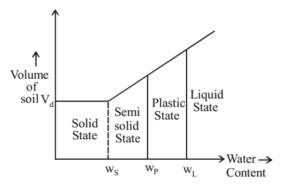
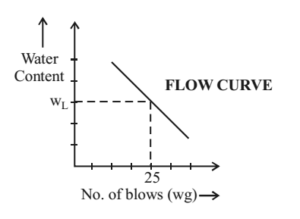
LIQUID LIMIT (WL)
- It is the minimum water content in which soil is in the liquid state. x Liquid limit is found out using Casagrande’s apparatus.
- Using this apparatus we find out the minimum water content at which soil man cut by a grooving tool (as confirm to IS 9259 – 1987) of standard dimension will flow together for a distance of 0.5 inches (12 mm) under impact of 25 blows.
- Using Casagrandes’ apparatus, with different water content and finding out no of blows, we get the flow curve.

n1 & n2 are number of blows corresponding to water contents w1 & w2.
- Shear strength of soil at liquid limit is about 2.7 kN/m2.
PLASTIC LIMIT (WP)
- Minimum water content in which soil turns from plastic state to semisolid state.
- It is found out by Thread test.
- Water content at which soil when rolled into a thread of 3.18 mm (1/8 of an inch), begins to crumble is called plastic limit.
SHRINKAGE LIMIT (WS)
- Maximum water content at which further decrease in water content cause any reduction in volume of solid mass is called shrinkage limit.
- At this limit the soil stops shrinking and volume remains constant. This volume is the day volume of soil (Vd).
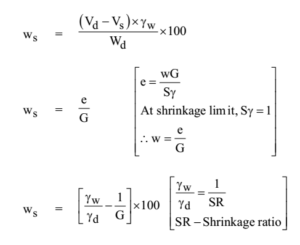
Shrinkage ratio (SR) – It is defined as the ratio of given volume change, expressed as a percentage of dry volume, to the corresponding change in water content.
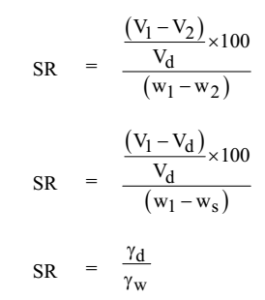
SR = Gm (mass specific gravity of soil in dry state)
V1 – Volume of soil mass at water content w1
V2 – Volume of soil mass at water content w2
Vd – Volume of dry soil mass.
ws – Shrinkage limit
Volumetric Shrinkage (VS) – It is the change in volume expressed as a percentage of dry volume when water content is reduced from given value to shrinkage limit.
VS = 100(V1-Vd)/Vd
SR = VS/(w1-w2)
Linear Shrinkage (LS) – It is the percentage change in length to actual length when water content is reduced to Shrinkage Limit.
LS = 100(Initial Length – Final Length)/Initial Length
Indices in Atterberg limits
1. Plasticity Index. (IP)
It is the numerical difference between liquid limit and plastic limit.
It denotes the width of plastic state in water content – volume graph. IP = wL – wP
When IP = 0, there is no plastic state and soil is said to be non-plastic.
When IP > 17, soil is said to be highly plastic. Eg: Clayey soil.
2. Shrinkage Index (IS)
It is the numerical difference between plastic limit and shrinkage limit. IS = wP – wS
It denotes the width of semi solid state in water content-volume graph.
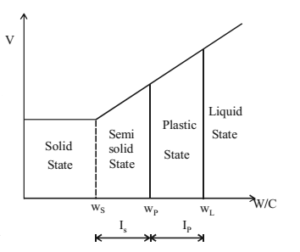
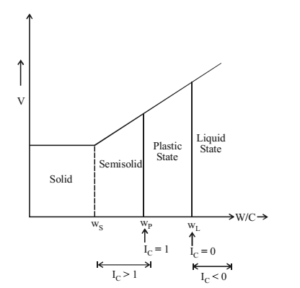
3. Consistency Index/ Relative consistency (IC)
IC = (wL – w)/(wL – wP) where w = weigh content of soil
= wL – w / IP
Different Cases
- When IC = 1, (wL – w)/(wL – wP) = 1 → wL – w = wL – wP → w = wPe., soil is in plastic state.
- When IC = 0, (wL – w)/(wL – wP) = 0 → wL – w > 0 → w = wLe., soil is in liquid state.
- When IC > 1, (wL – w)/(wL – wP) > 1 → wL – w > wL – wP → w < wPe., soil is in semisolid state.
- When IC < 0, (wL – w)/(wL – wP) < 0 → wL – w < 0 → w > wLe., soil is in liquid state (IC is negative)
Points to be noted
- When consistency is less than 50 soil is soft.
- When consistency index is greater than 100 soil is very stiff.
4. Liquidity Index/ Water plasticity ratio (IL)
IL = (w – wP)/(wL – wP) = (w – wP)/IP
Similar to above, substituting various values for IL.
When IL = 0, w = wP i.e., soil is in plastic limit
When IL = 1, w = wL i.e., soil is in liquid limit
When IL > 1, w > wL i.e., soil is in liquid state
When IL < 0, w < wP i.e., soil is in semisolid state IC + IL = 1 or 100%
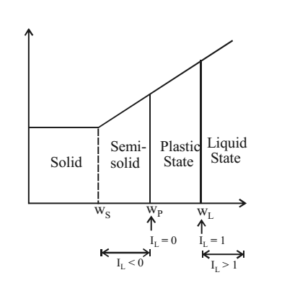
5. Toughness Index (IT) – Toughness Index is the ratio of plasticity index to flow index
IT = IP/IF
Points to be noted
- When particle size decreases, wL, wP and IP is increases
- When silt is added to clay, wL, wP and IP decreases
- As IT increases, strength of soil in plastic state increases.
Important Terms Related to Consistency
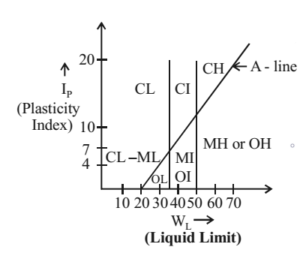
Activity (A) It is the ratio of plasticity index to percentage of clay fraction
A = IP / % clay
It is the measure of water holding capacity of clayey soil
If A < 0.75, soil is inactive.
If A is between 0.75 to 1.25, soil has normal activity
If A > 1.25, soil is active
Soil having clay mineral ‘montmorillonite has activity greater than 4
Thixotropy –
What is Thixotropy?
Gaining of strength of soil with passage of time after it has been remoulded is called thixotropy. It is due to gradual reorientation of molecules of water in the absorbed water layer and due to re-establishment of chemical equilibrium.
Sensitivity (S) It is the ratio between unconfined compressive strength of undistributed clay to union final compressive strength of remoulded clay/ soil.
S = UCS of undisturbed soil UCS of disturbed soil
When the soil structure is disturbed the engineering properties of soil changes considerably.
Sensitivity is the ratio of undisturbed strength to remoulded strength at the same water content.
Plasticity Chart
Equation of A line is IP = 0.73 (WL – 20) Note: IP = 0, wL = 20.
While drawing A line, it meets x-axis at 20.
When a question is asked with IP and WL to find the type of soil, draw the graph with A-line and locate the point on it with the given values of WL and IP see at which portion the point comes.
Representation
C – Inorganic Clay
M – Inorganic Silt
O – Organic clay/ Silt
L – Low compressible
I – Intermediate Compressible
H – High compressible
Example – CL means Low compressible inorganic clay. OH means High compressible organic clay/ silt.
PERMEABILITY
What is Permeability?
Permeability is the property of soil which permits the flow of water through its interconnected voids.
Darcy’s law :
Discharge, q = k.i.A
where k is Coefficient of permeability (cm/s or m/s or m/day)
i is hydraulic gradient or head loss/seepage length, i = Δh/l
A is Perpendicular cross sectional area
Discharge Velocity, V = q/A = k.i
Types of Soils and their values of K
Gravel – 1
Sand – 10-2
Silt – 10-4
Clay – 10-6
Seepage Velocity, VS = V/η
where η is porosity. Porosity will be always lesser than 1, so VS is always greater than V
Factors Affecting Coefficient of Permeability

(Comparing Darcy’s and Poiseuille’s Equation)
- k α γw where γw is unit weight of pore fluid
- k α 1/µ → k1/k2 = µ2/ µ1 where µ is viscocity of pore fluid
- k α e3/(1+e) ≈ e2 → k1/k2 = e12/e22 where e is void ratio
- k α DS2 where DS is diameter of grain.
- According to Allen Hazen equation, K = CD102 and C = 100 → K = 100D102 where D10 is effective diameter
- k depends on shape of article
- k is inversely proportional to specific surface area
- k depends on method of compaction during deposition and structural arrangement of soil mass
- Presence of undissolved gases, organic matter and other foreign matte
Determination of Coefficient of Permeability
– Laboratory methods
- Constant Head Permeability Method – This method is suitable for sand.
k = qL/HA (q = k.i.A = k x h/L x A)
Where q is discharge, L is seepage length, H is Head Loss, A is perpendicular cross sectional area
- Variable Head Permeability Test –This method is suitable for sand and silt.
k = aL/A x loge(h1/h2)/(t2-t1) = 2.303 (aL/At) log10(h1/h2)
where h1 and h2 are head drops corresponding to time t1 and t2
a is area of stand pipe
A is cross sectional area of solid specimen
– Field Methods
- Pumping out test
- Pumping in test
– From the particle size
Using Allen Hazen equation, k = C.DW2 where C ≈ 100
– From consolidation test data (Suitable for clays)
– Capillarity (Permeability Test)
Aquifers
- Confined Aquifer :
Discharge, q = 2.72(h2-h1)/loge(r2/r1)
Where h1 and h2 are depths of water in observation wells at distance of r1 and r2 (r2 > r1 )
- Unconfined Aquifer :
Discharge, q = 2.72k(H2-h2)/2log(R/r) = 1.36k(H2-h2)/log(R/r)
In Reccuperation test, specific yield k/A = 2.303 log(H1/H2)/T
Permeability of Stratified Deposit
Flow parallel to stratification plan
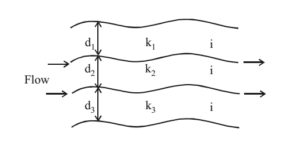
In this case, head loss and hydraulic gradient is constant.
Total Discharge Q = q1 + q2 + q3 + ……..
Permeability KH = k1d1+k2d2+…. / d1+d2+….
Flow perpendicular to stratification plane

In this case, discharge is constant.
Total Head Loss, H = h1+h2+h3+……
Permeability kv = d1+d2+…./(∂1/k1+∂2/k2+…..)
i.e. d1+d2+d3+…./kv = d1/k1 + d2/k2 + ….
Note: Always kH is greater than kv. Flow parallel to stratification plane is governed by most permeable layer and flow perpendicular to stratification plane is governed by least permeable layer.
SEEPAGE
Percolation of water through soil pores due to an external force or energy gradient is known as seepage. Total head in soil causing seepage is the sum of pressure head and datum head (velocity head is neglected due to low velocity of percolation).
i.e., H = hw ± z
Hydraulic gradient (i)
It is the loss of head per unit seepage distance. i = h/L
Flowline (stream line)
Path along which water particle percolates is called flowline or streamline.
Equipotential line
Equipotential line is the line joining points of equal total head. In an equipotential line, total head is constant but pressure heads are different and datum heads are also different. A piezometer will rise to an equal elevation at all points in an equipotential line. This elevation is called piezometric level.
Flow net – Combination of flow lines and equipotential lines.
Flow path (flow channel) – Space between two adjacent flow lines.
Field – Space between two adjacent flow lines and adjacent equipotential lines. Flow lines are approximately squares in shape
Seepage quantity (discharge) – Total discharge through a flow net.
q = k.H.Nf/Nd
where k is coefficient of permeability, H is Head causing flow, Nf is Number of flow channels, Nd is Number of potential drops
Seepage Pressure (PS) – It is the change in effective pressure due to seepage.
PS = H.rw = i.z.rw
H is hydraulic potential after n potential drops
H = h – n.ΔH
ΔH = h/Nd
h — total head causing flow.
Seepage force per unit volume = i.rw
Uplift Pressure (Pu)
At any depth, Pu = rw.hw
Where hw is pressure head at that depth = total head – datum head
Exit gradient – It is the hydraulic gradient where percolating water leaves the soil mass and emerges into free water.
Exit gradient, ie = ΔH/Δl
ΔH = h/Nd (potential/head drop)
Δl is the average length of last field at downstream end
Points to be noted
- Flow lines and equipotential lines are perpendicular to each other.
- Two flow lines or two equipotential lines never meet each other.
- Drop in total head between adjacent equipotential lines is the same.
- Flow net does not depend on permeability of soil (k) and head causing flow (H). It depends only on boundary conditions.
- Quantity of seepage in each flow channel in the same.
QUICK SAND
What is Quick Sand?
Quick sand is a condition in fine sand that occurs when seepage is in the upward direction. When the seepage pressure acts in the upward direction and if it becomes equal to the submerged weight of soil, effective pressure becomes zero.
In this case, the cohesionless soil losses all its shear strength and it moves in upward direction.
This phenomenon is called quick sand condition/boiling condition.
Downward force = submerged weight of soil = γ’.H (H is thickness of soil)
Upward Force = seepage pressure = γw.h (h is head causing flow)
At quick sand condition, γ’.H = γw.h
Head Required for Quick Sand:
γ’.H = γw.h
Head required, h = γ’.H/ γw
If there is a surcharge, it is also a downward force against seepage.
Therefore, Total Downward Force = γ’.H + q
- Head causing flow, h = (γ’.H + q)/γw
Critical Hydraulic Gradient (ic) – Hydraulic gradient at quick sand condition is called critical hydraulic gradient. At quick sand condition, exit gradient is equal or just greater than critical hydraulic gradient.
ic = h/H = γ’/γw = (G-1)/(1+e) = (G-1)(1-η)
h is head causing flow
H is thickness of sand
γ’ = γsub
1/(1+e) = 1-η (Since e = η/1-η)
Special Case: When G=2.67 and e=0.67, ic = (G-1)/(1+e) = (2.67-1)/(1+0.67) = 1
Points to be noted
- Quick sand is not a type of sand. It is a phenomenon that occurs on sand and other cohensionless soil.
- Quick sand condition occurs only in cohensionless soil (silt & fine sands)
PIPING
What is Piping phenomenon?
During quick sand condition, soil loses its shear strength and has the tendency to move in the direction of seepage flow. Thus the sand particles flows along with seepage water. This phenomenon is called piping. Piping is common in dams.
Factor of safety against quick sand/piping:
F = Critical hydraulic gradient/exit gradient = ic/ie
Seepage in anisotropic soil – When water seeps through soils of different permeabilities, the principle of square flow net is not valid.
Equivalent Permeability, k’ = Square root of kx.ky
When water flows from soil of one permeability to another, flow lines and equipotential lines gets deflected at the junction. Ratio of tangents of the angles made by these lines is equal to the ratio of permeabilities of the soils.

tanθ1/tanθ2 = k1/k2
EFFECTIVE STRESS
Total stress at base of soil column = Total force or load per unit area
σ = γsat x h
Pore water pressure/neutral stress (µ) – It is the pressure due to pore water in the voids.
µ = γw.h
Effective stress – It is the pressure exerted among the soil particles. So it is also called ‘intergranular pressure’

Points to be noted
- Effective stress cannot be measured directly with a given soil. It can only be calculated from other quantities.
- Effective stress in soil with varying water table levels. While calculating effective stress, we take bulk unit weight for soil above water table and saturated unit weight for soil below water table level.
Consider an example. Let’s take datum xx at a distance (h1 + h2) from ground surface and water table level at depth of h1 from surface.

Total Stress, σ = γh1+γsath2
Pore Pressure, µ = γw.h2
Effective Stress,
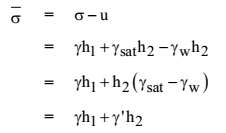
Now consider another case that water level was at a distance x from the previous case.
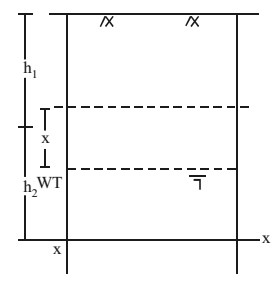

γ’ is always less than γ, hence (γx – γ’x) is a positive value
i.e., effective stress in 2nd case is more than that of first case. Therefore as water table gets depressed (comes down), effective stress increases and vice versa.
How to find effective stress in any case of datum and water table level
Consider individual heights of different layers of soil and multiply it by corresponding density values. For soil layers above water table take bulk unit weight (γ) and for soil layers below w.t. take saturated unit wt. (γsat).
To find pore water pressure, take sum of heights of soil layers from water table till datum and multiply by γw. If the section we consider is above water table level, pore water pressure is zero.
To find effective stress, take the difference of total stress and pore water pressure and remember γsat – γw = γ’ or γsub
Go through the below example.
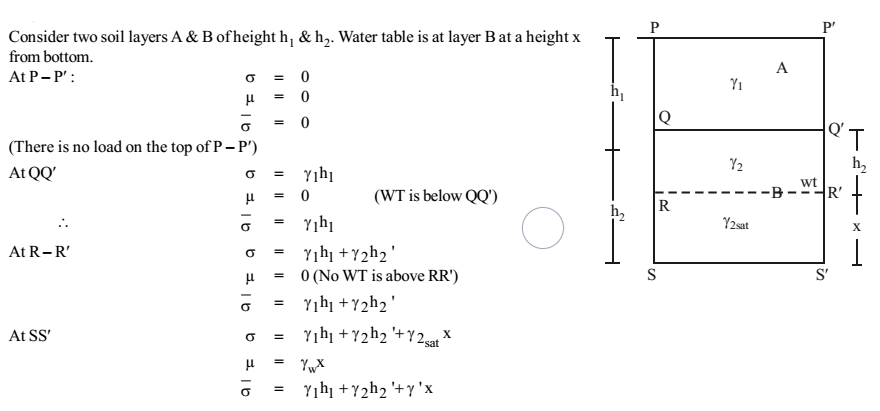
STRESS DISTRIBUTION
Consider a load Q acting on a soil layer. The vertical stress (V2) at a point P which is at a vertical distance z below the load and a radial distance of r, is given by Bousinesq’s equation


Points to be noted
- Bousinesq’s equation is used mainly for shallow foundation
- It is applicable to any soil at V2 does not depend on young’s modulus (E) and poisson’s ratio of soil.
- Theoretically, V2 = 0 only at infinite distance but it becomes negligible after some distance below the surface.
Special Case – When the point P is on the vertical line of load Q, r=0
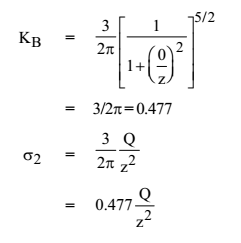
Variation of Vertical Stress
Case 1: Variation of σ2 in horizontal direction
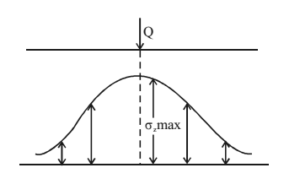
Case 2: Variation of V2 in vertical direction below the load
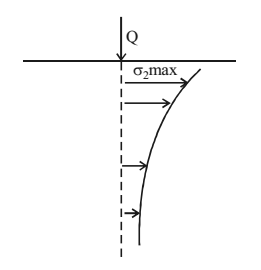
It varies parabolically as σ2 α 1/z2
Case 3: Variation of V2 in vertical direction at a radial distance r from load
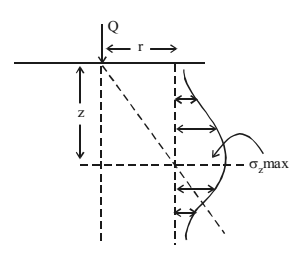
σ2 is maximum when r/z = 0.817
β = tan-1(r/z) = 39015’
Isobar
What is an Isobar?
It is the contour connecting points of equal vertical stresses. The presence of soil inside an isobar is greater than pressure of soil outside that isobar. The zone in the soil mass surrounded by isobar is called pressure bulb.
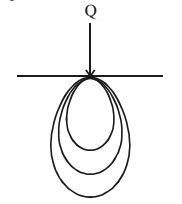
Vertical stress due to circular loaded area – Vertical stress at a point at depth z along the centre of circular area having radius ‘r’.

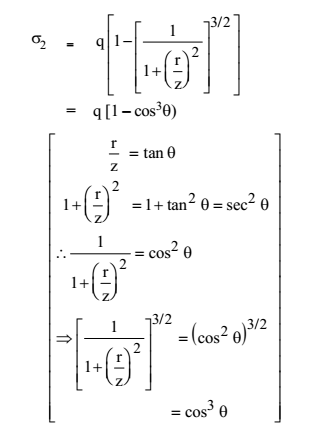
Newmarks influence chart
It is a chart based on Bousinesq’s theory which is used to find vertical stress below loaded area of dry shape.
Vertical stress, σz = I.n.q
Where I is Influenze coefficient (≈0.005 i.e., 5×10-3)
n is number of sectors occupied by footing in the chart
q is Intensity of loading
Westergaards Theory – This is also used to find vertical stress which is suitable for stratified soil and clays.
σz = Q/z2 x 1/π x [1/(1 + 2(r/z)2)]3/2
Note : Note the three charges of this equation with the Bousinesq’s Equation.
CONSOLIDATION –
What is Consolidation?
Consolidation is the phenomenon of gradual compression of soil mass by expulsion of water from the voids/ pore due to long term static load/ pressure. This is different from compaction, as compaction is expulsion of air and is of shorter duration. Consolidation takes place in three stages of expulsion of air, water and high viscous liquids known as initial, primary and secondary consolidation respectively.
Terzaghi’s Piston and spring model
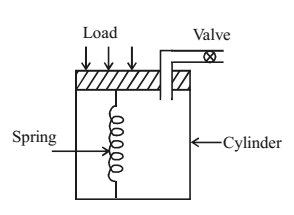
| Actual Material/Property | Model |
| Soil Grains | Spring |
| Voids | Cylinder |
| Effective Stress in Soil | Load on Spring |
| Effective Pore pressure | Load on Water |
| Permeability | Valve |
Compression Index (CC) It is the slope of log of stress and void ratio graph.
CC = (e1 – e1)/log10(σ1/σ0)
Where e0 and e1 are initial and final void ratios (e0 > e1)
σ0 and σ1 are corresponding initial and final stresses (σ1 > σ0)
Determination of Cc
Cc = 0.007 (wl – 10) For remoulded soil
Cc = 0.009 (wc – 10) For undisturbed soil
wl – liquid limit (in%)
Empirical formula Cc = 0.54 (e0 – 0.35) where e0 is in situ void ratio
Recompression Index (Cr)
Recompression is compression of soil which was already loaded and unloaded. This is much less compared to compression index.
Coefficient of Compressibility (av) – It is the, decrease in void ratio with unit increase in stress.
av = e0-e1/σ1-σ0
Coefficient of volume compressibility (mv)
mv = ΔV/V x 1/Δσ
For laterally confined soil, mv = ΔH/H x 1/Δσ = Δe/1+e0 x 1/Δσ
ΔH is called consolidation settlement (Sf)
Consolidation Settlement (Sf or DH)
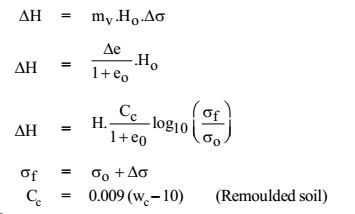
Δσ is increase in effective stress
Over Consolidation Ratio (OCR)
What is the Over Consolidation Ratio?
If a soil mass was subjected to higher pressure or stress (σc) in the past than the present pressure (σ), the ratio of that higher pressure to present pressure is called over consolidation ratio.
OCR = σc/σ
OCR will be less than 1, if there was no higher pressure acting on the soil than the present pressure acting on it (under consolidated soil).
Coefficient of consolidation (Cv)
Coefficient of consolidation, Cv is given by Cv = k/mv.γw (m2/s)
Where k is coefficient of permeability
mv is coefficient of compressibility
Time Factor (Tv)
Time factor (Tv) is given by, Tv = Cv.t/d2
Where C is coefficient of consolidation
t is Time taken for consolidation
d is drainage path
Value of d = H for single drainange, H/2 for double drainage
[This equation is important for gate exam and note the value of d. For double drainage it is not 2H but is H/2]. Time taken for consolidation, t is directly proportional to d2
t1/t2 = (d1/d2)2
Cv is constant for a soil and Tv is same for same degree of consolidation.
Determination of coefficient of consolidation
1. Square root time fitting method.
(Tv)90 = Cvxt90/d2
t90 is time taken for 90% consolidation
2. Logarithmic time fitting method
Cv = (TV)50 x d2 / t50
(Tv)50 is time factor for 50% consolidation = 0.197
Degree of Consolidation (u)
u = (Settlement at any time/Ultimate Settlement) x 100
= S/Sf x 100
U = Dissipated excess pore water pressure/Initial excess pore water pressure = (ui-u/ui) x 100
Where ui is initial even pore water pressure and u is pore water pressure at given time
When u ≤ 60%, Tv = π/4 x (u/100)2 (u in %)
When u > 60%, Tv = 1.781 – 0.933 log10(100-u)
COMPACTION
What is Compaction?
Compaction is the process of increasing unit weight of soil by expulsion of air from the voids by applying an external force (rolling, tamping etc.)
Relation between dry density and water constant is γd = Gγw/1+e
Optimum moisture content (OMC)
When water is added to dry soil, the adsorbed water acts as lubricant by forming a thin film around the soil grains. Thus on applying external load soil is well compacted and dry density gets increased. When the water content is increased, the water starts occupying the space between soil grains, hindering close packing of grains during compaction. Thus dry density decreases. Thus we have, to find the optimum water content at which we get maximum compaction and eventually the maximum dry density. This maximum dry density obtained is called proctor density. The amount of compactum and OMC is found by standard proctor compaction test or by modified proctor test (more efficient)
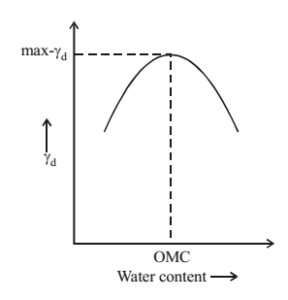
Zero air void line – It is the plot between dry unit weight and water content corresponding to 100% degree of saturation or zero air voids. Equation of zero air void line
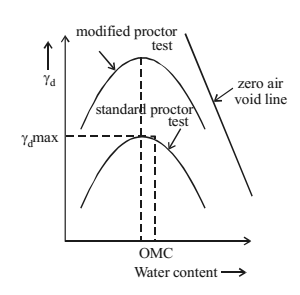
Equation of zero void line

Sr = 100% , ηa = 0 and w is water content of compacted soil
Relative Compaction = (Dry Density in field/maximum dry density obtained) x 100
SHEAR STRENGTH
What is Shear Strength?
It is the resistance of shearing of soil particles when a shear stress acts on it, due to structural resistance due to interlocking, frictional resistance and cohesion.
Mohr-coulomb theory – Shear strength (τ) is expressed as a function of normal stress (σ)
τ = C + σ.Tanφ
where c is apparent cohesion (kN/m2) and φ is angle of shearing resistance
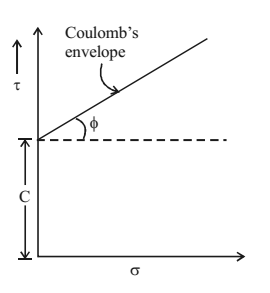
Terzaghi’s theory – Shear stress (τ) is expressed as a function of effective normal stress (σ’)
τ = C’ + σ’ tanφ’
where C’ is effective cohesion, σ’ is effective stress (σ-u) and φ’ is angle of internal friction
Normal stress (σ’) and shear stress (τ) on any plane inclined at an angle α to the major principle plane can be expressed in terms of effective major principle stress σ’, and effective minor principle stress σ3’
σ’ = (σ1’+ σ3’)/2 + (σ1’- σ3’)Cos2α/2
τ = (σ1’- σ3’)Sin2α/2
The graphical representation of these two equation give Mohr stress circle
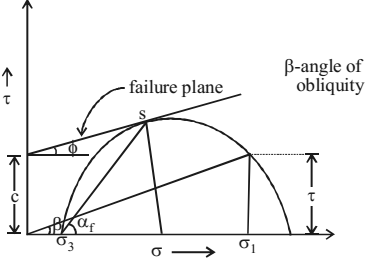
Critical shear plane – Critical shear plane is obtained from minimum difference (τf – τ) is taken we get.
αf = 45 + φ/2
The critical shear plane is at an angle of αf with major principle plane shown in figure.
Different types of tests for shear strength
Different types of tests are conducted for shear strength calculation based on the drainage condition.
- Unconsolidated – undrained Test (UV – Test) or Quick test (Q–test) No drainage during both consolidation and shear stage. Takes only 5-10 minutes to complete. Example – unconfined compression test, Vane shear test
- Consolidated – undrained test (Cu Test) or Rapid Test (R – Test) Drainage is permitted only in consolidation stage and not during shear stage.
- Consolidated – Drained Test (CD test) or slow Test (S–Test) Drainage is permitted during both consolidation and shear stage. Taken 2–5 days to complete.
Points to be noted
For any combinations of σ1’ and σ3’ failure will occur only if mohr stress circle touches failure plane.
The shear stress at failure is less than maximum shear stress. i.e. failure plane does not carry maximum shear stress In terms of total stress,
τf = Cu + σ tan φu
where Cu is apparent cohesion and φu is apparent angle of shearing resistance.
DIFFERENT TEST FOR SHEAR STRENGTH
1. Direct shear Test – In direct shear test, for different values of vertical load, we find the failure shear stress and we plot the mohr circle with values of normal stress at each test. The shear strength parameters are then found out from the graph.

Shear strength, τ = c + σ tanφ
2. Triaxial Compression Test
Cell Pressure = σ3 = σc = Confining pressure
Deviator stress, σd = σ1 – σ3
In the first staged this test, cell pressure (σc) is applied from all sides. In the second stage, deviator stress (σd) is given axially.
Thus, in axial direction total stress = σd + σc = σ1 – σ3 + σ3 = σ1
Deviation stress, σd = additional axial load/area at failure or changed cross sectional area
= additional axial load/A’
A’ = V1±ΔV/L1-ΔL (drained triaxial test)
A’ = A0/1-(ΔL/L)
Where A0 is initial area, V1 is initial volume, ΔV and ΔL are change in volume and length respectively
ΔL/L = e = axial strain
Tip: Remember the equations of cell pressure and deviator stress. Questions are usually asked from this equations.
3. Unconfined compression test
Before going to the details of the test, it is important to know about plastic equilibrium.
Plastic Equilibrium – A material is said to be in plastic equilibrium when every point of it is at the verge of failure. The following equations are valid at plastic equilibrium.
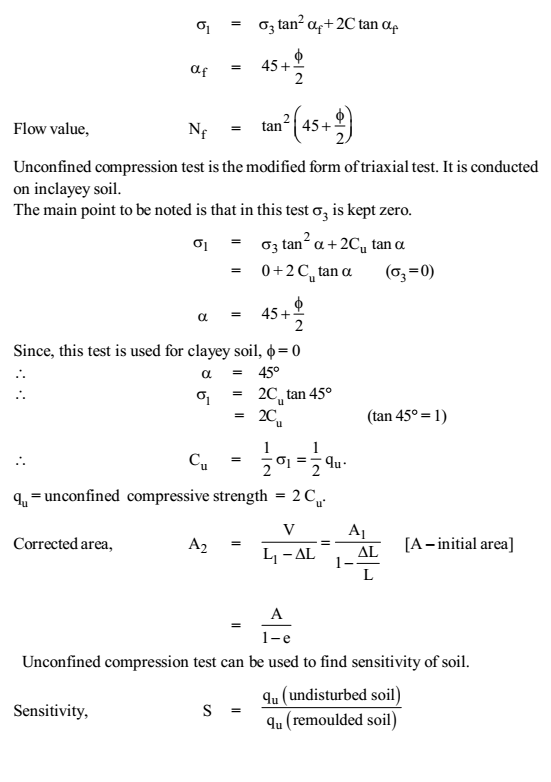

4. Vane Shear Test
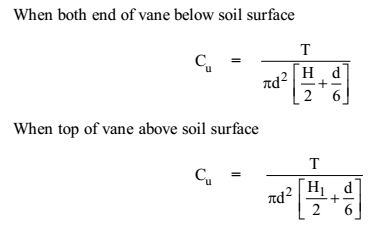
where,
T – torque
Cu – undrained cohesion of soil
H – height of vane
H1 = height of vane below soil sample
d – diameter of vane
As per IS recommendation, H = 2d.
Tip: Check if the top end of vane is above or below soil when a question is asked about vane shear test. Remember to take H1 in second case and not total height H.
DOWNLOAD LINK OF THIS WHOLE MATERIAL IN PDF FORMAT : CLICK HERE
PASSWORD : CivilEnggForAll
OTHER USEFUL LINKS FROM CIVILENGGFORALL
ENVIRONMENTAL ENGINEERING ENGINEERING SERVICES IES ESE EXAM ACE NOTES : CLICK HERE
GEOTECHNICAL ENGINEERING ENGINEERING SERVICES IES ESE EXAM ACE NOTES : CLICK HERE
RCC ACE ACADEMY IES EXAM HANDWRITTEN NOTES : CLICK HERE
STRENGTH OF MATERIALS ACE ACADEMY IES EXAM NOTES : CLICK HERE
TRANSPORTATION ENGINEERING ACE ACADEMY IES EXAM NOTES : CLICK HERE
HYDROLOGY ACE ACADEMY IES EXAM NOTES : CLICK HERE
IRRIGATION ACE ACADEMY IES EXAM NOTES : CLICK HERE
SURVEYING ACE ACADEMY IES EXAM NOTES : CLICK HERE
MATHS MADE EASY HANDWRITTEN NOTES : CLICK HERE
REASONING AND APTITUDE MADE EASY GATE HANDWRITTEN NOTES : CLICK HERE
OPEN CHANNEL FLOW MADE EASY GATE HANDWRITTEN NOTES : CLICK HERE
ENGINEERING MECHANICS MADE EASY GATE HANDWRITTEN NOTES : CLICK HERE

Leave a Reply